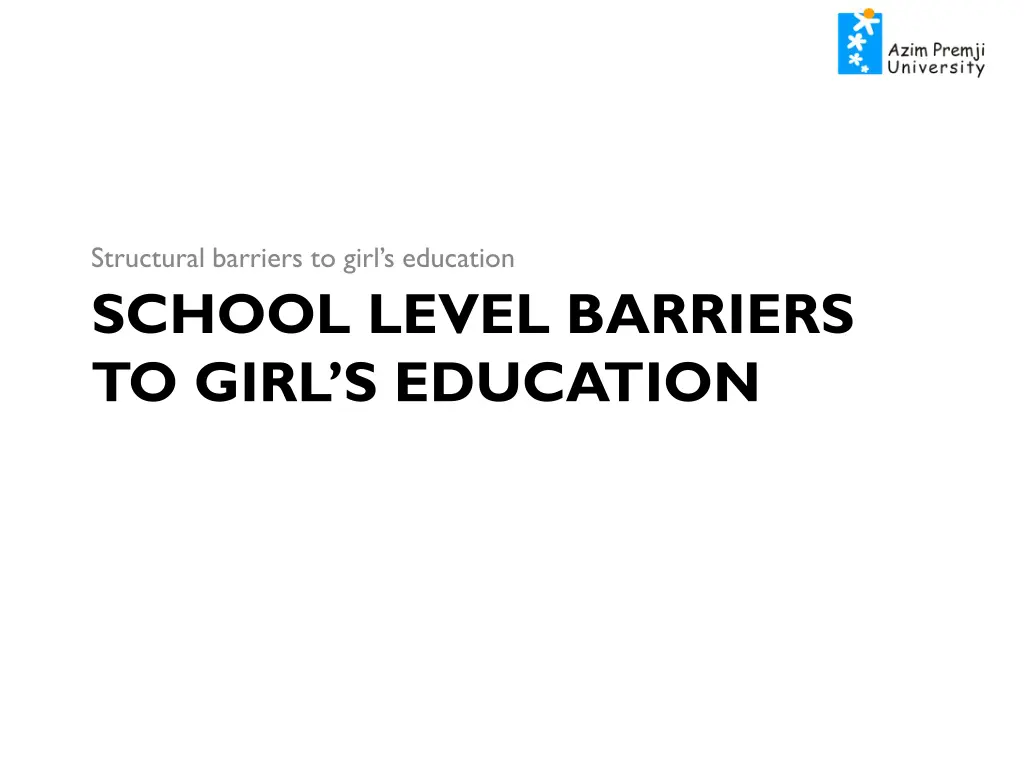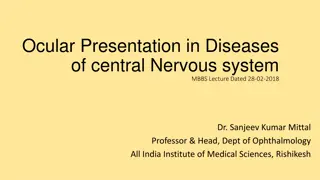
Challenges in Girls' Education: School-Level Barriers
Explore the structural and institutional barriers to girls' education at the school level, including issues related to location, health, traditions, religion, and early marriage. Learn about the categorization of barriers based on their origin and their impact on girls' access to education. Discover alternative approaches to addressing barriers in girls' education, along with insights on Karnataka's secondary school system and infrastructure status.
Download Presentation

Please find below an Image/Link to download the presentation.
The content on the website is provided AS IS for your information and personal use only. It may not be sold, licensed, or shared on other websites without obtaining consent from the author. If you encounter any issues during the download, it is possible that the publisher has removed the file from their server.
You are allowed to download the files provided on this website for personal or commercial use, subject to the condition that they are used lawfully. All files are the property of their respective owners.
The content on the website is provided AS IS for your information and personal use only. It may not be sold, licensed, or shared on other websites without obtaining consent from the author.
E N D
Presentation Transcript
Structural barriers to girls education SCHOOL LEVEL BARRIERS TO GIRL S EDUCATION
Barriers to girls education - I Institutional Capacity School s Location Health Traditions / Religion Early Marriage Adapted from a 2005 Mozambique report on barriers to girls education
Barriers to girls education - II School s Location limited access Health Traditions / Religion Early Marriage Adapted from a 2005 Mozambique report on barriers to girls education
Categorizing the barriers Framework based on location of the barriers: System barriers School barriers Household barriers - Household / Community level (costs direct & in-direct; practices traditional, cultural, religious, .; health; crisis instability; ) School based (access; poor infra; inadequacy of content; learning deficiency; health issues; conflicts negative aspects; ) Policy / System level (laws not in place; weak enforcement; inadequate budget allocations; outdated curriculum; poor processes; system collapse chaos;...) - -
Alternative approach School level barriers Barriers (Girl s education and gender equality, UNICEF, 2014): Barriers to girls education range from supply-side constraints to negative social norms . Adolescent girls face additional economic and social demands impacting their education negatively. Issues related to power relations between males and females in schools and society at large play a vital role in determining the barriers.
Background Karnataka secondary schools 15k schools (of the 2.25L in the country) 5% all girls schools Enrolled Secondary Students % of rural secondary schools 80 70 70 60 56 50 808961 48% 876374 52% 40 30 20 10 Girls Boys 0 Karnataka India Total secondary students:16,85,335; 48% girls 56% rural Source: DISE 2013-14
Infra status HPS-Secondary school ratio: 2.32 (2.6) Students per class: 46 (reduced from 72) Average no. of classrooms: 2.5 (3.3) PTR: 15 (26) Single classroom schools: 1% Boundary wall: 76% (83%) Electricity: 95% (86%) Computers: 73% (62%) / internet: 28% (34%) Library: 97% Girls toilet: 99.78% / hand-wash near toilet: 32% (54%) Source: DISE 2013-14
The 15+ year girl child in Karnataka The story: Transition rate for girls: Elem. to Sec.: 91% Net enrollment ratio (girls): 55% (gross: 78%) Secondary level girls promotion rate: 60%; means drop-out 40%! 85.2% pass (girls) versus 82.2% (boys) Ratio of boys to girls enrollment 0.93 (secondary) / 1.08 (HS)! Open school enrollment: 9766 boys versus 2503 girls (class X) Areas of concern / school level barriers: PTA: 9% (38%) 1.1L teachers: only 40% female Teacher qualification below graduation: 33% (10%); but % of professionally qualified teachers is 95%! Source: DISE 2013-14
Anecdote from the malnad Secondary school A : Situated 25 kms off the National highway 6 year old school 115 students (56% girls) 8 staff (no science teachers) 3 feeder schools one of the feeder schools is 6 kms. away without public transport Most girls walk the distance; some boys cycle Every single class VII girl child from the feeder schools joins this high school All students pass class X Every single class X girl child in this school joins higher secondary
WHY? WHY? Eradicate the school level barriers Eradicate the school level barriers other barriers vanish! other barriers vanish!






















